Introduction: Why International Subaru Owners Need This Guide
When your TPMS Subaru (Tire Pressure Monitoring System) warning light comes on, many owners try the “universal method” to reset it, but often find it ineffective. The issue may lie in “regional differences + model variations”—for example, the North American Outback lacks a physical reset button, European models require towing mode adaptation, and the Solterra electric model needs to have its high-voltage battery turned off first.
Based on Subaru’s latest Technical Service Manual, this guide follows the “Type → Method → Regional Adaptation → Troubleshooting” logic to offer detailed TPMS reset steps for TPMS Subaru across various models. It covers both combustion engine models (like Forester, Outback, Legacy) and electric vehicles (like Solterra), with information on PSI/bar dual pressure units, international tool purchasing channels, and regional regulatory requirements. This guide enables Subaru owners worldwide to quickly reset their TPMS Subaru system at home in 5-15 minutes, avoiding the extra $200-500 fees at the dealership.
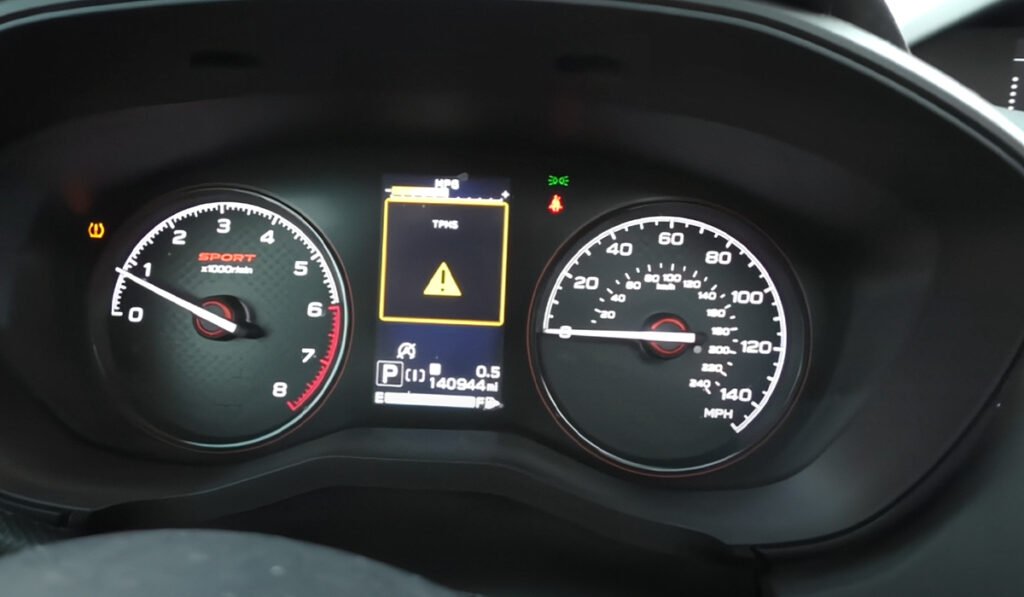
Step 1: Precisely Determine the TPMS Type in 40 Seconds (Incorrect Judgment = Waste of Effort)
The TPMS Subaru system is divided into two types: Indirect TPMS and Direct TPMS. The 2024 Solterra continues with the direct TPMS technology, but with special hardware considerations for electric vehicles. Below are the three key methods to quickly distinguish between the two types of TPMS Subaru systems:
| Comparison Metric | Indirect TPMS Subaru (Indirect TPMS) | Direct TPMS Subaru (Direct TPMS) | 2024 Solterra Subaru (Direct TPMS) |
|---|---|---|---|
| Core Principle | Uses ABS wheel speed sensors to estimate (low pressure → smaller tire diameter → faster speed) | Embedded sensors inside the tire (measuring pressure + temperature), wirelessly transmitting to the ECU (vehicle’s “brain”) | Same as direct TPMS Subaru, but with synchronization to the high-voltage battery system |
| Hardware Characteristics | Rubber valve, no built-in sensor; instrument panel lacks real-time tire pressure display | Metal valve base (sensor integrated); instrument panel displays individual tire pressures | Same as direct TPMS Subaru, but with an additional “high-voltage battery TPMS synchronization module” (left side of the trunk) |
| Applicable Models | 2005-2007 global models (2006 Forester, 2007 Legacy) | 2008-2023 all models (Outback, XV, Crosstrek) | 2024 Solterra Subaru (North America/Europe/Japan market) |
| Quick Identification | 1. Check the valve: Rubber → Indirect; 2. Check the display: No individual tire pressure → Indirect | 1. Check the valve: Metal with a wire → Direct; 2. Check the display: Shows individual tire pressures → Direct | 1. Check the model: Solterra Subaru electric → Direct; 2. Check the trunk: Has a red high-voltage switch → Exclusive to electric model |
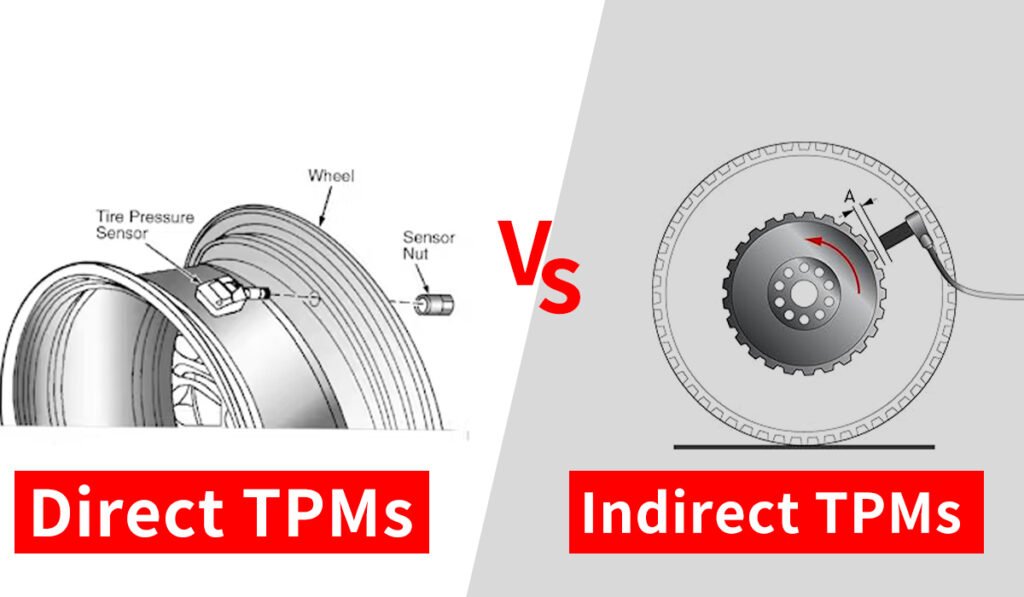
Technical Authority Supplement: Subaru was one of the first brands to equip all models with direct TPMS Subaru systems (since 2008, two years ahead of Toyota and one year ahead of Honda). The 2024 direct TPMS Subaru system now supports “dynamic calibration”—allowing the system to update tire pressure baselines in real-time while driving, improving response time by 30% compared to the 2023 model (data source: Subaru Official Technical Documents).
Step 2: Type-Based, Year-Based, and Model-Specific Operations (Including 2024 Electric Models)
(A) Indirect TPMS (2005-2007 Models): Manual, No Tools
The TPMS Subaru system uses wheel speed sensors to estimate tire pressure. When the light comes on, it indicates a mismatch between wheel speed data and tire pressure baseline. The system needs to synchronize the new baseline.
Method 1: Button Reset (Common to 2006 Forester / 2007 Legacy)
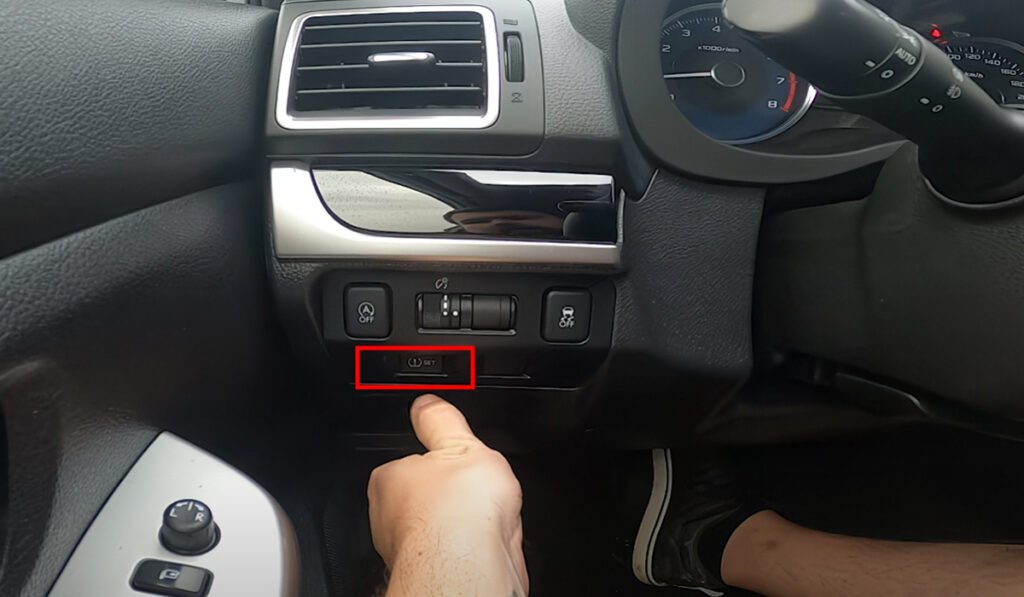
✅ 1. Cold Tire Pressure Calibration:
Park the car for ≥ 3 hours (or drive ≤ 1 km, tire temperature ≤ 35°C) and use a tire pressure gauge (recommended precision ±0.1 bar) to inflate all tires (including the spare) to the B-pillar label values (e.g., 2006 Forester: front tires 33 PSI/2.3 bar, rear tires 30 PSI/2.1 bar).
Note: The B-pillar label is usually on the driver’s side door frame, visible when the door is open. Some older models label it as “Tire Pressure.”
✅ 2. Power-on Trigger:
Turn the ignition switch to “OFF” and hold the “TPMS Reset Button” (black circle, approximately 1 cm in diameter, labeled “SET” in some models) located below the dashboard.
Keep pressing the button while turning the key to the “ON” position (without starting the engine to avoid battery drainage), hold for 3-5 seconds.
✅ 3. Confirmation of Success:
You will hear one beep (or the TPMS Subaru light will blink three times). Release the button → turn off the ignition for 10 seconds and restart. If the light goes off, the reset is complete.
If no beep: Check if the button is fully pressed or if the key is properly in the “ON” position (older models may need an extra turn to activate the circuit).
Method 2: Menu Reset (2007 Models with Multifunction Steering Wheel)
✅ 1. Enter the Menu:
With the ignition on but not starting the engine, press the “Mode” button on the steering wheel (labeled “INFO” in some models), then navigate to the “Vehicle Settings” menu.
✅ 2. Select the Function:
Move the cursor to “Tire Pressure Calibration,” then select “Reset.”
✅ 3. Confirm the Operation:
The instrument panel will show a popup, “Are all tires properly inflated?” Press “OK,” and after 3 seconds, the display will read “Calibration Complete,” and the light will turn off.
⚠️ International Users Note: The indirect TPMS Subaru system cannot identify which tire is leaking. If the light remains on after resetting, measure the tire pressure one by one (using brands like Michelin or Goodyear for global use), repair the tire, and repeat the reset.
(B) Direct TPMS (2008-2024 Models): Divided into “Routine Reset,” “Sensor Pairing,” and “Electric Model Specific”
The TPMS Subaru system contains built-in sensors and operates in three distinct scenarios. The 2024 Solterra Subaru requires special attention to the high-voltage battery switch:
Scene 1: Routine Reset (No Sensor Change, Such as Tire Pressure Adjustment / Repair)
Select the method based on the year and region, with newer models (2022 and later) supporting automatic learning:
| Year Range | Representative Model (International) | Operation Steps | Regional Special Notes |
|---|---|---|---|
| 2008-2017 | 2015 Outback (North America), 2016 XV (Europe) | 1. Inflate cold tires to the standard value. 2. Power on without starting the engine and hold the brake left-side reset button for 3-5 seconds (light flashes). 3. Drive 30-60 km/h for 10-15 minutes, light off. | North America: 2017 models may lack a reset button, use an OBD tool; Europe: Rainy weather road tests need 20 minutes (to avoid sensor signal interference) |
| 2018-2021 | 2020 Forester (Australia), 2021 Legacy (Japan) | Button version: Same as 2008-2017, drive 5-8 minutes; Central control version: Power on → “Vehicle Settings → Tires → Tire Pressure Reset” → click “Start,” light off. | Australia: Reset button needs to be held for 7 seconds (to strengthen calibration on gravel roads); Japan: Central control language selectable in Japanese/English, select “タイヤ圧リセット” (Tire Pressure Reset) |
| 2022-2023 | 2023 Crosstrek (Southeast Asia), 2022 Outback (China) | Auto learning: Power on → “Settings → Vehicle → TPMS Calibration” → system will automatically scan within 5 minutes, light off; Only tire pressure adjustment: Power on and calibrate automatically after 10 minutes. | Southeast Asia: Monthly tire pressure check due to high temperatures; China: Central control path simplified to “Settings → Tires → One-Click Reset” |
| 2024 Models (Gasoline) | 2024 Forester (Global), 2024 Legacy (North America) | Same as 2022-2023, added “Tire Pressure Abnormality Reminder” (Instrument panel displays specific leaking tire). | Global: Supports Subaru StarLink app sync, with calibration notification pushed to the app after completion. |
| 2024 Solterra Subaru (Electric) | 2024 Solterra (North America/Europe/Japan) | 1. Turn off high-voltage battery: Use a small wrench to turn the red switch in the trunk to “OFF” (to avoid electric shock). 2. Follow 2022-2023 automatic learning steps. 3. After operation, turn back to “ON,” restart the vehicle. | North America: First connect the vehicle to the charging gun for 10 minutes to activate the TPMS Subaru module; Europe: Turn off “Energy Recovery Mode” (to avoid affecting sensor data). |
Scene 2: Sensor Pairing (After Sensor Replacement, Such as Battery Death or Damage)
The direct TPMS Subaru sensor has a “unique ID + regional frequency” (433 MHz in North America/Asia, 315 MHz in Europe, and 433 MHz globally for 2024 Solterra), which must be written to the ECU for recognition:
2.1 DIY Matching: Using an OBD Tire Pressure Matching Tool
After replacing the TPMS Subaru sensor, its unique ID must be registered to the vehicle’s ECU. Using an OBD programming TPMS matching tool is the most direct and reliable solution.
✅ Tool Selection: Core Features and Recommended Models
When choosing a tool, make sure it has the following features:
• OBD Programming: Must communicate with the vehicle’s ECU via the OBD interface and complete ID registration.
• Sensor Activation: Can wirelessly wake up and read the tire sensor signals.
• Model Coverage: Clearly supports the Subaru TPMS models in your region.
For purchasing OEM TPMS Sensors, check this OEM TPMS Sensor link. For purchasing TPMS Matching Tools, visit this TPMS Tool link.
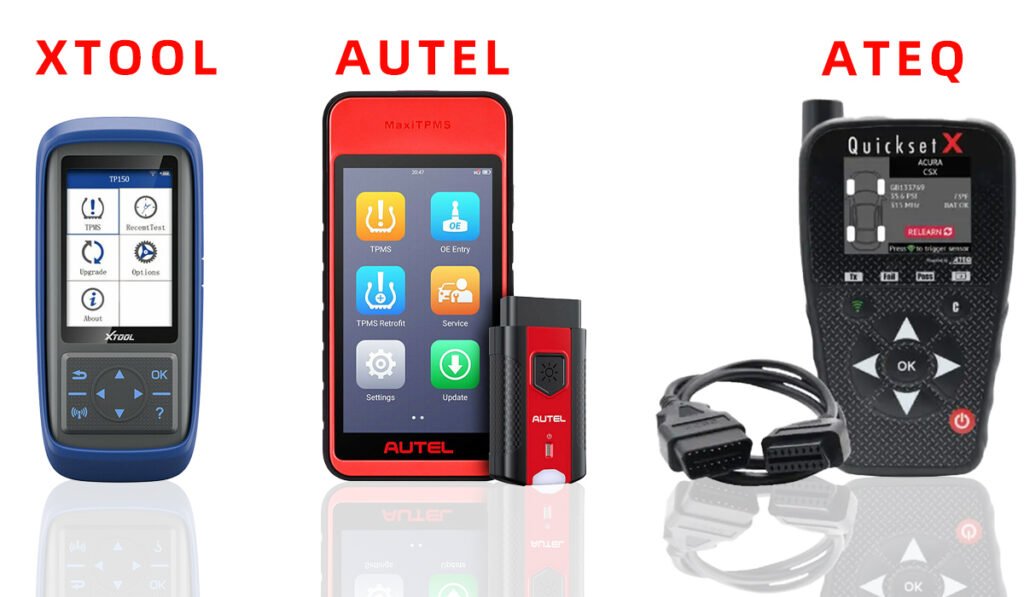
Main Recommended Models (All support the full process above):
• Autel TS508
• ATEQ VT46
• Launch T100
✅ Standard Operation Process
- Activate Vehicle Learning Mode
Follow the steps from Scene 1: Routine Reset for your model to make the TPMS Subaru indicator light flash quickly, indicating the vehicle is ready. - Connect OBD and Perform Programming
• Connect the matching tool to the OBD-II interface under the steering wheel.
• In the tool menu, select your Subaru model, enter the “Programming” or “Sensor Learning” function.
• Follow the screen prompts to sequentially read the tire sensor IDs (left front → right front → right rear → left rear), and the tool will automatically complete ECU registration. - Complete Verification and Special Synchronization
• When the tool shows “Success” and the TPMS Subaru indicator light goes off, the pairing is successful.
• (For Solterra models only): After completing, press and hold the steering wheel “OK” button for 5 seconds to synchronize the high-voltage system with the TPMS Subaru module.
Step 3: Regional Special TPMS Operations (Latest Adaptation)
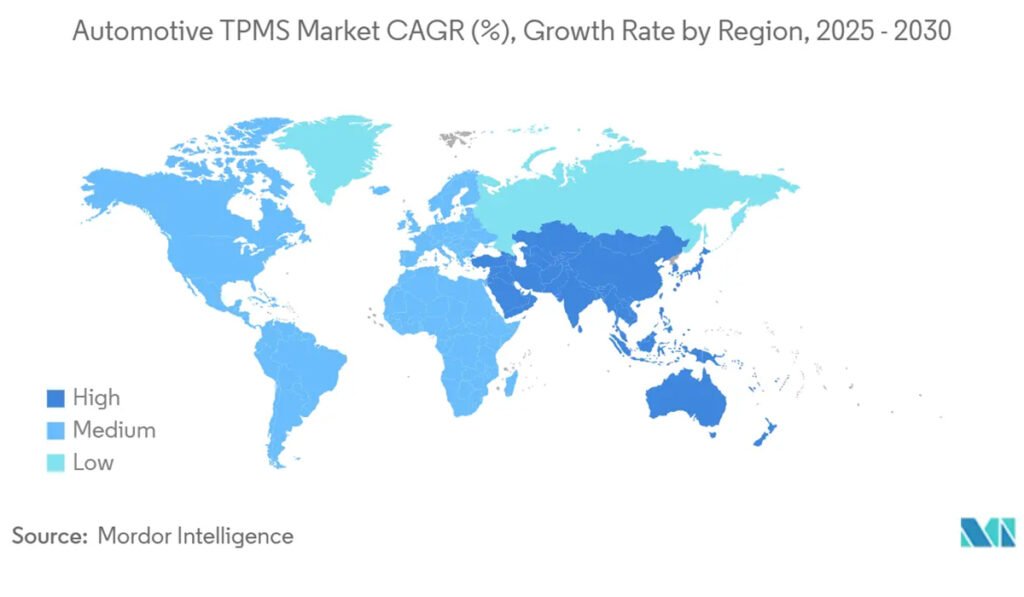
When performing TPMS resets for different regions, there are specific guidelines and regulations that need to be followed based on your TPMS Subaru system. Below are the key regional requirements:
| Region | Representative Models | Special Operation Details | Regulatory Requirements |
|---|---|---|---|
| North America | Solterra, Outback | 1. No physical reset button, must operate through central control. 2. Sensor replacement requires “DOT certification” (tire production date). 3. Winter tire pressure should be reduced by 10% (e.g., 33 PSI → 30 PSI) | Aftermarket sensors must meet FMVSS 138 standard, or the vehicle will fail inspection. |
| Europe | Solterra, XV | 1. Supports “Towing Mode”: inflate the rear tires to 34 PSI/2.4 bar, select “Towing Mode” on the central control before resetting. 2. Sensors must meet ECE R64 certification. 3. Annual sensor battery checks required. | Starting in 2024, TPMS data must be uploaded in real-time to the vehicle cloud platform; reset data must be synchronized. |
| Australia | Forester, Legacy | 1. Reset button requires a 7-second hold (normally 3-5 seconds) to adapt to gravel roads. 2. Spare tire does not need a sensor (marked “Temporary Use Only”). 3. Sensor lifespan reduced to 5 years (high temperatures). | Must use Australia-standard tire pressure gauges (units: kPa/PSI dual display). |
| Japan (Domestic) | Solterra, Legacy JDM models | 1. No menu/buttons, must use STIS tool for pairing. 2. Download “TPMS Initialization Software” from Subaru Japan’s website. 3. Operations must be conducted in Japanese. | Sensor IDs must be filed with Japan’s Ministry of Transportation, otherwise considered illegal modifications. |
| Southeast Asia | XV, Forester | 1. Turn off air conditioning before resetting (to avoid electrical interference). 2. Sensor battery checked annually (high temperatures cause faster degradation). 3. Road tests must be on paved roads (to avoid weak signal from muddy roads). | Aftermarket sensors without certification are prohibited, violations may lead to fines up to $1000. |
Further Key Additions (Essential for International Users)
- Universal Tire Pressure Standards (Cold Tire, Updated)
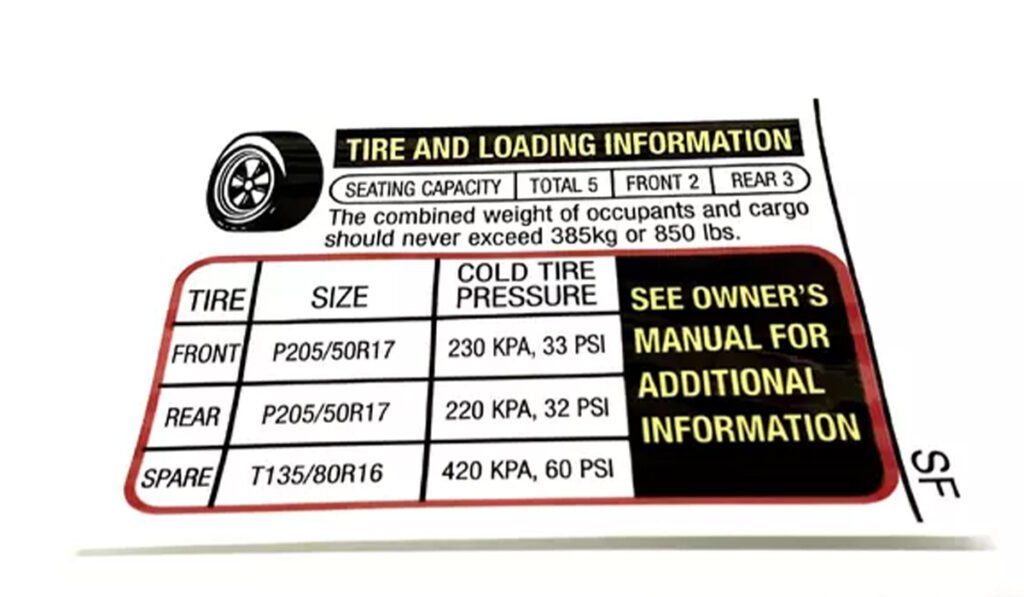
| Model Series | Front Tires (PSI/bar/kPa) | Rear Tires (Regular Load) | Rear Tires (Fully Loaded with 5 People + Luggage) |
|---|---|---|---|
| Solterra Electric | 34/2.35/235 | 34/2.35/235 | 36/2.48/248 |
| Outback (Legacy) | 33/2.3/230 | 30/2.1/210 | 33/2.3/230 |
| Forester | 33/2.3/230 | 32/2.2/220 | 34/2.4/240 |
| XV/Crosstrek | 32/2.2/220 | 30/2.1/210 | 32/2.2/220 |
| Legacy | 33/2.3/230 | 30/2.1/210 | 33/2.3/230 |
Note: The kPa unit applies to Europe/Asia markets. Cold tire definition: Parking for ≥3 hours, or driving ≤1 km (tire temperature ≤35°C).
- International Safety Pitfalls (Avoiding Cross-Border Repairs)
⚠️ Voltage Mismatch: Purchasing a FASLINK U508 from China to Europe without using a voltage converter (220V → 110V) can damage the tool. Be sure to select a 110-220V global version for international tools.
⚠️ Electric Vehicle Risk: If the Solterra Subaru high-voltage battery is not turned off before resetting, it may trigger a “high voltage error code” (which needs to be cleared at the dealership for a fee of $300).
⚠️ Frequency Mismatch: Using 433 MHz sensors (North America frequency) in Europe will cause the TPMS Subaru light to stay on. The 315 MHz sensor (with ECE R64 certification) must be used instead.
⚠️ Excessive Torque: Using a standard wrench to tighten the valve stem when installing sensors can over-tighten the ceramic sensor probe. It’s recommended to use a torque wrench (brands like Craftsman).
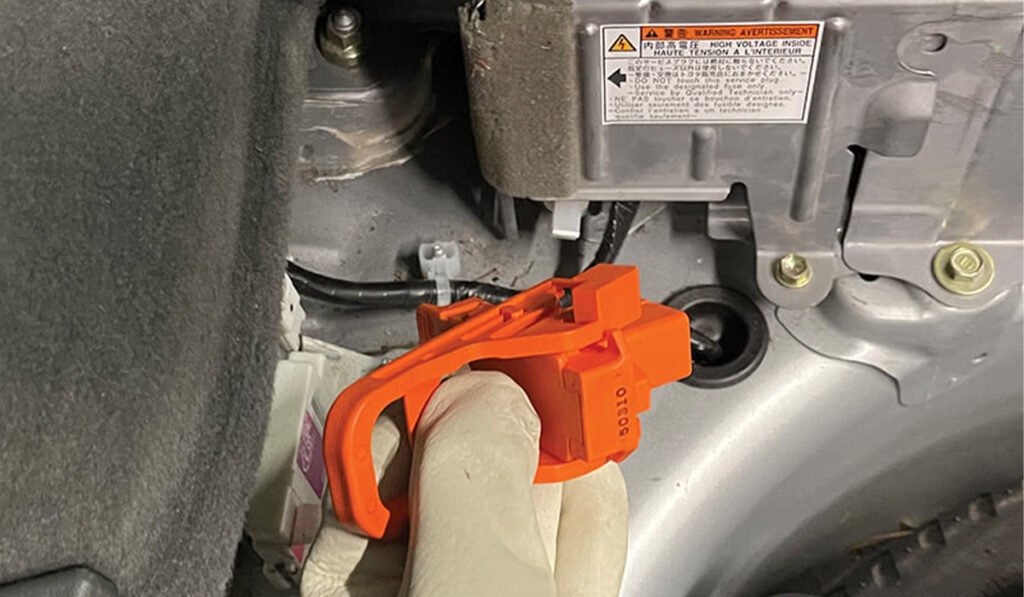
Troubleshooting (2025 Models and Electric Vehicles)
| Fault Phenomenon | Applicable Models | Cause Analysis | International Solution (Step-by-Step) |
|---|---|---|---|
| TPMS Light On, Normal Tire Pressure, P0500 Error | 2005-2007 Indirect Models | Wheel speed sensor contamination (dirt/metal shavings) or coil damage | 1. Remove wheel, clean the inside of the wheel rim sensor (don’t use hard objects). 2. Reinstall and reset. 3. If it persists, replace the sensor (purchase OEM on Amazon: “Subaru Wheel Speed Sensor”). |
| ID Mismatch Error | 2008-2023 Direct Models | Incorrect aftermarket ID format (not 8 characters of letters + numbers) or frequency mismatch | 1. Use Autel TS401 to read the ID and confirm format. 2. If format is wrong, rewrite ID (select “Subaru ID Format” in the tool). 3. If frequency is wrong, replace with corresponding frequency sensor. |
| Solterra Reset, High Voltage Light On | Solterra Subaru | High-voltage battery and TPMS Subaru module not synchronized, or switch not turned “ON” | 1. Turn the high-voltage switch to “ON”. 2. Connect the charging gun for 10 minutes. 3. Hold the “OK” button on the steering wheel for 5 seconds to synchronize. 4. If it still persists, contact Subaru EV support (website: “EV Support”). |
| Towing Mode Error (European Models) | 2024 XV (European version) | Towing mode not disabled or rear tires under 34 PSI | 1. Disable “Towing Mode” on the central control. 2. Inflate rear tires to 34 PSI. 3. Reset. 4. If error persists, use TS401 to clear error code. |
FAQ (Frequently Asked Questions) – Common Queries from International Users
Q1: After purchasing a 2024 Solterra from the United States, the TPMS light comes on in Europe. What should I do?
A1: The TPMS Subaru system in the US Solterra uses 433 MHz sensors, but in Europe, 315 MHz sensors are required. You will need to replace all four sensors with European-certified sensors (with ECE R64 certification). Then, use the Autel TS401 tool to program them. Additionally, make sure to switch the central control to “Region Mode” (select “Europe”), or the calibration will not be effective.
Q2: Is it normal for the sensor battery to last only 4 years for users in Australia?
A2: Yes, this is normal. In Australia, the high temperatures accelerate the loss of electrolyte in the TPMS Subaru sensors, which shortens the battery life from the standard 6-8 years to 4-6 years. We recommend using the FASLINK U508 to check the battery level annually, and replace the sensors when the voltage drops below 2.0V to avoid the TPMS warning light turning on unexpectedly.
Q3: What should I do if my tool cannot connect to the OBD interface during DIY matching?
A3:
- First, check if the OBD interface has power (you can use a 12V OBD Test Light available on Amazon).
- If it’s not powered, check the fuse in the engine compartment (look for the “OBD” or “DLC” fuse, and replace it with a 15A fuse).
- If it’s powered but the tool still won’t connect, replace the data cable (the international version usually comes with two cables, look for the Subaru OBD Cable).
Q4: How do I reset the TPMS if I’m using a JDM (Japanese Domestic Market) Legacy without a reset button?
A4:
- Download the TPMS Initialization Software from Subaru Japan’s official website (you must register for an account and select the “JDM models” option).
- Connect the computer to the OBD interface using a USB-OBD cable (search for “Subaru JDM OBD Cable“).
- Open the software, select “TPMS Reset,” and follow the on-screen instructions (the interface supports both Japanese and English).
Summary
In this TPMS Subaru Reset Ultimate Guide, we provide global owners with detailed steps for resetting their TPMS system, covering everything from identifying TPMS types and model-specific procedures to region-specific requirements. Whether you drive a gasoline vehicle or an electric model like the 2024 Solterra, you can follow the detailed steps in this guide to complete the TPMS Subaru reset, avoiding costly dealership repair fees.
By following this guide, you can accurately identify your vehicle’s TPMS type and use the correct tools and methods for a quick reset, ensuring that your tire pressure monitoring system is functioning properly and improving driving safety. If you encounter any issues, you can also refer to the frequently asked questions (FAQ) section to help you resolve them more effectively.
Make sure to follow the correct steps each time you perform a reset, and pay attention to region-specific regulations. By doing so, you can easily fix any TPMS warning light issues, ensuring the safety of your vehicle and enhancing your driving experience. If you face more complex issues, it is advisable to use the proper tools or seek professional help to ensure the proper calibration and functioning of your TPMS Subaru system.
